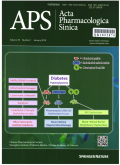- 钛学术文献服务平台 \
- 学术期刊 \
- 医药卫生期刊 \
- 药学期刊 \
- 中国药理学报(英文版)期刊 \
Aristolochic acid I promoted clonal expansion but did not induce hepatocellular carcinoma in adult rats
Aristolochic acid I promoted clonal expansion but did not induce hepatocellular carcinoma in adult rats
基本信息来源于合作网站,原文需代理用户跳转至来源网站获取
摘要:
Aristolochic acid I (AAI) is a well-known nephrotoxic carcinogen,which is currently reported to be also associated with hepatocellular carcinoma (HCC).Whether AAI is a direct hepatocarcinogen remains controversial.In this study we investigated the association between AAI exposure and HCC in adult rats using a sensitive rat liver bioassay with several cofactors.Formation of glutathione S-transferase placental form-positive (GST-P+) foci was used as the marker for preneoplastic lesions/clonal expansion.We first conducted a medium-term (8 weeks) study to investigate whether AAI had any tumor-initiating or-promoting activity.Then a long-term (52 weeks) study was conducted to determine whether AAI can directly induce HCC.We showed that oral administration of single dose of AAI (20,50,or 100 mg/kg) in combination with partial hepatectomy (PH) to stimulate liver proliferation did not induce typical GST-P+ foci in liver.In the 8-week study,only high dose of AAI (10 mg· kg-1· d-1,5 days a week for 6 weeks) in combination with PH significantly increased the number and area of GST-P+ foci initiated by diethylnitrosamine(DEN) in liver.Similarly,only high dose of AAI (10 mg· kg-1· d-1,5 days a week for 52 weeks) in combination with PH significantly increased the number and area of hepatic GST-P+ foci in the 52-week study.No any nodules or HCC were observed in liver of any AAI-treated groups.In contrast,long-term administration of AAI (0.1,1,10 mg· kg-1· d-1) time-and dose-dependently caused death due to the occurrence of cancers in the forestomach,intestine,and/or kidney.Besides,AAI-DNA adducts accumulated in the forestomach,kidney,and liver in a time-and dose-dependent manner.Taken together,AAI promotes clonal expansion only in the high-dose group but did not induce any nodules or HCC in liver of adult rats till their deaths caused by cancers developed in the forestomach,intestine,and/or kidney.Findings from our animal studies will pave the way for further large-scale epidemiological investigation of the associations between AA and HCC.

推荐文章
Influence of litter decomposition on iron and manganese in the sediments of wetlands for acid mine d
AMD
Sediments
Litter decomposition
Forms of Fe and Mn
Nephrotoxicity and carcinogenesis of aristolochic acids and their derivates
马兜铃酸
马兜铃酸肾病
肾毒性
致癌性
Rock chemical weathering by sulfuric acid: pathway, method and prospect
Chemical weathering
Sulfuric acid
Global climate change
Sulfate isotope
内容分析
关键词云
关键词热度
相关文献总数
(/次)
(/年)
文献信息
| 篇名 | Aristolochic acid I promoted clonal expansion but did not induce hepatocellular carcinoma in adult rats | ||
| 来源期刊 | 中国药理学报(英文版) | 学科 | |
| 关键词 | |||
| 年,卷(期) | 2021,(12) | 所属期刊栏目 | Hepatic Pharmacology |
| 研究方向 | 页码范围 | 2094-2105 | |
| 页数 | 12页 | 分类号 | |
| 字数 | 语种 | 英文 | |
| DOI | |||
五维指标
引文网络
引文网络
二级参考文献 (0)
共引文献 (0)
参考文献 (0)
节点文献
引证文献 (0)
同被引文献 (0)
二级引证文献 (0)
2021(0)
- 参考文献(0)
- 二级参考文献(0)
- 引证文献(0)
- 二级引证文献(0)
引文网络交叉学科
相关学者/机构
期刊影响力
中国药理学报(英文版)
主办单位:
中国药理学会和中科院上海药物研究所
出版周期:
月刊
ISSN:
1671-4083
CN:
31-1347/R
开本:
大16开
出版地:
上海市太原路294号
邮发代号:
4-295
创刊时间:
1980
语种:
eng
出版文献量(篇)
4416
总下载数(次)
2
总被引数(次)
42236
期刊文献
相关文献
推荐文献
- 期刊分类
- 期刊(年)
- 期刊(期)
- 期刊推荐
中国药理学报(英文版)2022
中国药理学报(英文版)2021
中国药理学报(英文版)2020
中国药理学报(英文版)2019
中国药理学报(英文版)2018
中国药理学报(英文版)2017
中国药理学报(英文版)2016
中国药理学报(英文版)2015
中国药理学报(英文版)2014
中国药理学报(英文版)2013
中国药理学报(英文版)2012
中国药理学报(英文版)2011
中国药理学报(英文版)2010
中国药理学报(英文版)2009
中国药理学报(英文版)2008
中国药理学报(英文版)2007
中国药理学报(英文版)2006
中国药理学报(英文版)2005
中国药理学报(英文版)2004
中国药理学报(英文版)2003
中国药理学报(英文版)2002
中国药理学报(英文版)2001
中国药理学报(英文版)2000
中国药理学报(英文版)1999
中国药理学报(英文版)1998
中国药理学报(英文版)2021年第9期
中国药理学报(英文版)2021年第8期
中国药理学报(英文版)2021年第7期
中国药理学报(英文版)2021年第6期
中国药理学报(英文版)2021年第5期
中国药理学报(英文版)2021年第4期
中国药理学报(英文版)2021年第3期
中国药理学报(英文版)2021年第2期
中国药理学报(英文版)2021年第12期
中国药理学报(英文版)2021年第11期
中国药理学报(英文版)2021年第1期

 免费查重
免费查重










